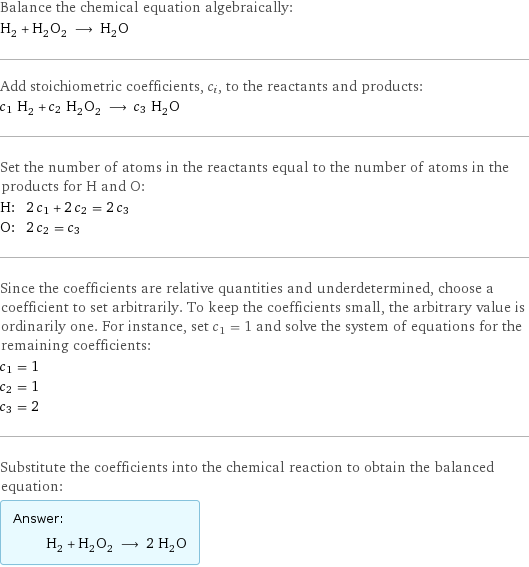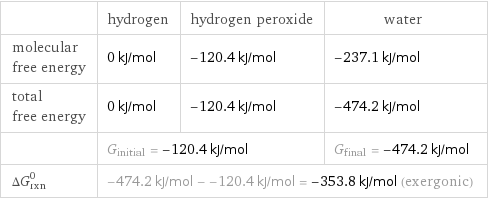Input interpretation

H_2 hydrogen + H_2O_2 hydrogen peroxide ⟶ H_2O water
Balanced equation

Balance the chemical equation algebraically: H_2 + H_2O_2 ⟶ H_2O Add stoichiometric coefficients, c_i, to the reactants and products: c_1 H_2 + c_2 H_2O_2 ⟶ c_3 H_2O Set the number of atoms in the reactants equal to the number of atoms in the products for H and O: H: | 2 c_1 + 2 c_2 = 2 c_3 O: | 2 c_2 = c_3 Since the coefficients are relative quantities and underdetermined, choose a coefficient to set arbitrarily. To keep the coefficients small, the arbitrary value is ordinarily one. For instance, set c_1 = 1 and solve the system of equations for the remaining coefficients: c_1 = 1 c_2 = 1 c_3 = 2 Substitute the coefficients into the chemical reaction to obtain the balanced equation: Answer: | | H_2 + H_2O_2 ⟶ 2 H_2O
Structures

+ ⟶
Names

hydrogen + hydrogen peroxide ⟶ water
Reaction thermodynamics
Gibbs free energy

| hydrogen | hydrogen peroxide | water molecular free energy | 0 kJ/mol | -120.4 kJ/mol | -237.1 kJ/mol total free energy | 0 kJ/mol | -120.4 kJ/mol | -474.2 kJ/mol | G_initial = -120.4 kJ/mol | | G_final = -474.2 kJ/mol ΔG_rxn^0 | -474.2 kJ/mol - -120.4 kJ/mol = -353.8 kJ/mol (exergonic) | |
Equilibrium constant
![Construct the equilibrium constant, K, expression for: H_2 + H_2O_2 ⟶ H_2O Plan: • Balance the chemical equation. • Determine the stoichiometric numbers. • Assemble the activity expression for each chemical species. • Use the activity expressions to build the equilibrium constant expression. Write the balanced chemical equation: H_2 + H_2O_2 ⟶ 2 H_2O Assign stoichiometric numbers, ν_i, using the stoichiometric coefficients, c_i, from the balanced chemical equation in the following manner: ν_i = -c_i for reactants and ν_i = c_i for products: chemical species | c_i | ν_i H_2 | 1 | -1 H_2O_2 | 1 | -1 H_2O | 2 | 2 Assemble the activity expressions accounting for the state of matter and ν_i: chemical species | c_i | ν_i | activity expression H_2 | 1 | -1 | ([H2])^(-1) H_2O_2 | 1 | -1 | ([H2O2])^(-1) H_2O | 2 | 2 | ([H2O])^2 The equilibrium constant symbol in the concentration basis is: K_c Mulitply the activity expressions to arrive at the K_c expression: Answer: | | K_c = ([H2])^(-1) ([H2O2])^(-1) ([H2O])^2 = ([H2O])^2/([H2] [H2O2])](../image_source/a39c85e10343e584a367da5828c00c86.png)
Construct the equilibrium constant, K, expression for: H_2 + H_2O_2 ⟶ H_2O Plan: • Balance the chemical equation. • Determine the stoichiometric numbers. • Assemble the activity expression for each chemical species. • Use the activity expressions to build the equilibrium constant expression. Write the balanced chemical equation: H_2 + H_2O_2 ⟶ 2 H_2O Assign stoichiometric numbers, ν_i, using the stoichiometric coefficients, c_i, from the balanced chemical equation in the following manner: ν_i = -c_i for reactants and ν_i = c_i for products: chemical species | c_i | ν_i H_2 | 1 | -1 H_2O_2 | 1 | -1 H_2O | 2 | 2 Assemble the activity expressions accounting for the state of matter and ν_i: chemical species | c_i | ν_i | activity expression H_2 | 1 | -1 | ([H2])^(-1) H_2O_2 | 1 | -1 | ([H2O2])^(-1) H_2O | 2 | 2 | ([H2O])^2 The equilibrium constant symbol in the concentration basis is: K_c Mulitply the activity expressions to arrive at the K_c expression: Answer: | | K_c = ([H2])^(-1) ([H2O2])^(-1) ([H2O])^2 = ([H2O])^2/([H2] [H2O2])
Rate of reaction
![Construct the rate of reaction expression for: H_2 + H_2O_2 ⟶ H_2O Plan: • Balance the chemical equation. • Determine the stoichiometric numbers. • Assemble the rate term for each chemical species. • Write the rate of reaction expression. Write the balanced chemical equation: H_2 + H_2O_2 ⟶ 2 H_2O Assign stoichiometric numbers, ν_i, using the stoichiometric coefficients, c_i, from the balanced chemical equation in the following manner: ν_i = -c_i for reactants and ν_i = c_i for products: chemical species | c_i | ν_i H_2 | 1 | -1 H_2O_2 | 1 | -1 H_2O | 2 | 2 The rate term for each chemical species, B_i, is 1/ν_i(Δ[B_i])/(Δt) where [B_i] is the amount concentration and t is time: chemical species | c_i | ν_i | rate term H_2 | 1 | -1 | -(Δ[H2])/(Δt) H_2O_2 | 1 | -1 | -(Δ[H2O2])/(Δt) H_2O | 2 | 2 | 1/2 (Δ[H2O])/(Δt) (for infinitesimal rate of change, replace Δ with d) Set the rate terms equal to each other to arrive at the rate expression: Answer: | | rate = -(Δ[H2])/(Δt) = -(Δ[H2O2])/(Δt) = 1/2 (Δ[H2O])/(Δt) (assuming constant volume and no accumulation of intermediates or side products)](../image_source/2175e008773baafde64b057eddd01423.png)
Construct the rate of reaction expression for: H_2 + H_2O_2 ⟶ H_2O Plan: • Balance the chemical equation. • Determine the stoichiometric numbers. • Assemble the rate term for each chemical species. • Write the rate of reaction expression. Write the balanced chemical equation: H_2 + H_2O_2 ⟶ 2 H_2O Assign stoichiometric numbers, ν_i, using the stoichiometric coefficients, c_i, from the balanced chemical equation in the following manner: ν_i = -c_i for reactants and ν_i = c_i for products: chemical species | c_i | ν_i H_2 | 1 | -1 H_2O_2 | 1 | -1 H_2O | 2 | 2 The rate term for each chemical species, B_i, is 1/ν_i(Δ[B_i])/(Δt) where [B_i] is the amount concentration and t is time: chemical species | c_i | ν_i | rate term H_2 | 1 | -1 | -(Δ[H2])/(Δt) H_2O_2 | 1 | -1 | -(Δ[H2O2])/(Δt) H_2O | 2 | 2 | 1/2 (Δ[H2O])/(Δt) (for infinitesimal rate of change, replace Δ with d) Set the rate terms equal to each other to arrive at the rate expression: Answer: | | rate = -(Δ[H2])/(Δt) = -(Δ[H2O2])/(Δt) = 1/2 (Δ[H2O])/(Δt) (assuming constant volume and no accumulation of intermediates or side products)
Chemical names and formulas

| hydrogen | hydrogen peroxide | water formula | H_2 | H_2O_2 | H_2O name | hydrogen | hydrogen peroxide | water IUPAC name | molecular hydrogen | hydrogen peroxide | water